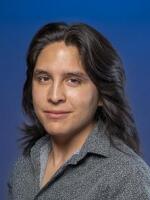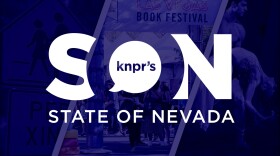Are you starting to see orange traffic cones in your sleep? They seem to be everywhere these days as road construction or infrastructure upgrades take place.
The truth is, it’s not that unusual because Las Vegas grows fast. But it just seems like there are more than ever, and more are coming.
For Formula 1 racing later this year, they’ll resurface almost four miles of around the Las Vegas Strip. Dropicana is here. The Centennial Bowl interchange is still happening. They’re building another lane on the Nevada-California border. They’ll be adding a dedicated bus lane on Maryland Parkway.
Then there’s the traffic from all the events here. F1 in November. The Super Bowl next year. Two NASCAR races each year. They block off lanes of Las Vegas Boulevard for the Rock ‘n' roll marathon, then on Memorial Day, and Fourth of July, New Year's Eve and Labor Day weekend, March Madness, Raiders games and more. And what if they build a baseball stadium on Las Vegas Boulevard?
Do our traffic engineers work in conjunction with all jurisdictions to stagger road work instead of doing it all at once? Do we need more than just buses? Do we really need light rail to California?
Jeff Lerud is deputy director of operations and maintenance for the Nevada Department of Transportation. He talks all things traffic with State of Nevada host Joe Schoenmann and Theresa Gaisser, the director of the Traffic Management Center at the Regional Transportation Commission of Southern Nevada.
INTERVIEW HIGHLIGHTS
Would it be possible to expand remote parking on the Las Vegas Strip?
GASSIER: I can't talk on behalf of the casino industry. But what I can tell you is one of our responsibilities at the TMC is to be the regional event traffic coordinator. So we work with partner agencies, we work with law enforcement, the DOT, the venues themselves, their on-site traffic managers. And what we're doing is we're assessing all of the major events that are coming into the region. And we're looking to make sure that we're taking on a coordinated approach to how we're managing those. And we've seen some great successes with the NFL Draft, for example, where because of the large scale and footprint of that event, it was determined, let's shut down Las Vegas Boulevard to make sure that there's room to accommodate all the people that we're anticipating. We see it every New Year's Eve with that event as well. I think that there's a lot of opportunities, and we're a unique city in that everybody is well coordinated. So there is the flexibility to have those conversations.
We’ve heard the RTC FAST facility is like being in a starship. What’s it like?
GAISSER: It feels a little bit like NASA. We do have a big wall of videos that we are watching all day long. These are the live traffic cameras. And what we're looking for is we're trying to see what's canvassing the roadways and seeing, is there congestion building on the freeways? Are there crashes that need mitigation? We're co-located at that facility with Nevada Highway Patrol with Nevada Department of Transportation and the 911 dispatchers from Nevada Public Safety. So it's a really engaging and coordinated effort at that facility.
“Dropicana” is the major project at I-15 and Tropicana. Can you talk about that?
LARUD: Tropicana [Avenue] was built back in the ‘60s, and it's only been widened one time since then. And what we've seen with it is, we're increasing the height over I-15. … We're raising that up to 16 and a half feet, we're adding capacity on Tropicana itself with an additional lane in each direction, we're maximizing the turn movements to promote the flow through the area. One of the biggest things that we're doing there is we're eliminating the signal at Dean Martin, which is on the west side there.
Additionally, we're actually going to build Tropicana longer over I-15 to have more room underneath this structure to promote future widening if we need it, which we will need because we'll be tying into Project Neon, which is in the north, and then our southern improvements, too.
If someone has a suggestion to improve traffic in Las Vegas, what can they do?
GAISSER: If you do have concerns like that you can reach out to local agencies … However, if there's something that you're seeing at traffic signals in general, regarding the operations, or maybe the equipment, we always want to hear from the public, we want to know what's happening. And even if it's not specifically for us at the Traffic Management Center, it may be for the local jurisdiction. So we like to be that one-stop phone call. It's at 702-901-8400 that you can contact us. You can also email us at askfast@rtcsnv.com.
Do local traffic agencies and law enforcement still have a partnership to determine the causes of crashes and how they're going to fix those high-collision intersections?
GAISSER: Even one fatal is one too many to be happening on our public roadways. So because of that we are constantly in coordination with all of the city traffic engineers, as well as local law enforcement, brainstorming on, how do we get people to change that driving behavior? Is it engineering? Do we design the roadways differently? Is it education or reminding people about speed limits and safe driving and wearing your seatbelt? Is it to the degree of law enforcement? But all in all, we are looking at technology as well to help us with this. And a big portion of this is where at RTC are kicking off a study based on some of those high crash locations we've gotten at intersections from the local agencies on how to determine red light running trends, as well as near misses and speeding.
LARUD: If you'd notice on say I-15 or U.S. 95, every once in a while you'll see an enforcement vehicle staged there. And the reason that it stays there is because we've recognized that during the time of day or or during the congestion period that accidents and crashes are a little more frequent in that area. So we have them staged there to have that presence and alert the motors to you know, be careful, slow down and really pay more attention.
From your perspective, and from NDOT’s perspective, what could be the impact of that high-speed rail from Southern California to Las Vegas?
LARUD: I'll tell you what, I think it would have a huge impact. We just recently partnered with California Caltrans to add an additional lane southbound into California for that return trip from Las Vegas.
But, is it for real?
LARUD: I'd like to think it is for real, because we just said it's going to have a great impact on the traffic coming to and from Las Vegas. I do know, like you said, that they want to break ground at the end of this year in hopes to be completed before the 2028 Olympics in LA. So they're moving fast.
My personal thoughts are I will be in line to get on that thing as soon as it gets built. I can't wait. As far as engineering is concerned, that's a heavy, heavy, heavy lift. I know as far as the funding and things like that to help make it a reality there. They're pursuing federal grants and things like that, and have been working with them to fill out those applications. But yeah, as far as the engineering is concerned, it's going to be really awesome to watch it develop.
RESOURCES
Guests: Theresa Gaisser, director, Traffic Management Center, Regional Transportation Commission of Southern Nevada; Jeff Lerud, deputy director of operations and maintenance, Nevada Department of Transportation










